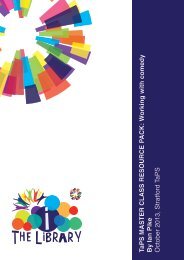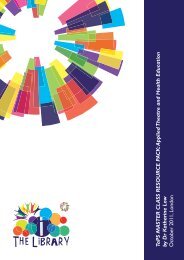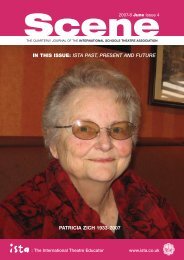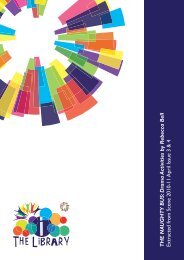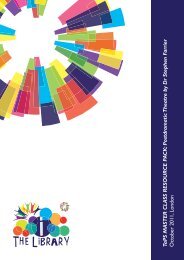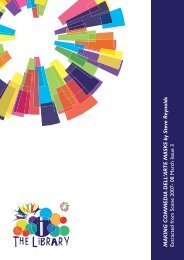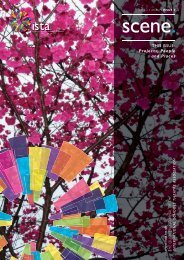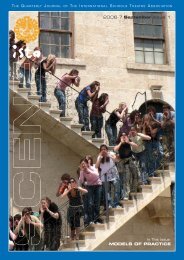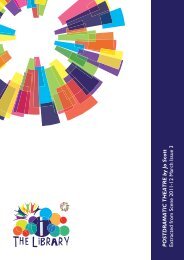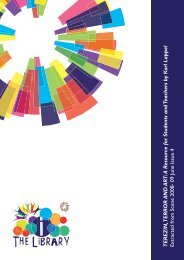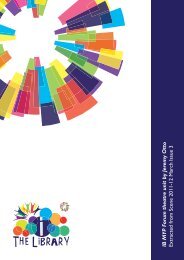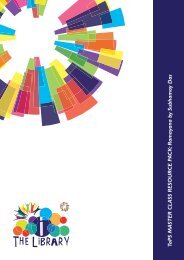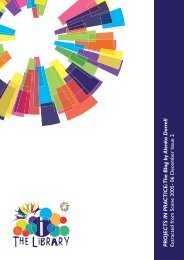ISTA/Scene March 07
ISTA/Scene March 07
ISTA/Scene March 07
Create successful ePaper yourself
Turn your PDF publications into a flip-book with our unique Google optimized e-Paper software.
for this show, although you can buy a<br />
sound effects tape from the publisher.<br />
The part we are most excited about is<br />
our Pink Panthers (PP’s). We have 7<br />
female and 5 male PP’s who function<br />
as entertainers between scenes but<br />
also move set and props on stage.<br />
This allows the show to run smoothly<br />
without the need to shut the curtain for<br />
set changes. Our dance<br />
choreographer also has them walking<br />
over chairs in the audience, belaying<br />
off the balcony and clowning for the<br />
audience during intermission. They<br />
have become as important to the story<br />
as the story itself. The students chosen<br />
as PPs were chosen based on their<br />
dance skills, gymnastics, athletic ability<br />
and/or circus skills. The PP’s are also<br />
developing their own specific<br />
personalities, such as the shy one, the<br />
rebel, the clown character, etc.<br />
Neil Harris and Flicky Lappish –<br />
Shatin College, Hong Kong<br />
OUR COUNTRY’S GOOD by<br />
Timberlake Wertenbaker<br />
The play is set in Australia 1789. A<br />
young lieutenant is directing rehearsals<br />
of the first play ever to be staged in that<br />
country. With only two copies of the<br />
text, a cast of convicts, and one leading<br />
lady who may be about to be hanged,<br />
they struggle on and eventually become<br />
transformed by the redemptive,<br />
transcendental power of theatre.<br />
In order to explore the play practically,<br />
we began by looking at Brechtian<br />
devices that might be used in order to<br />
tell the story more effectively: narration,<br />
cross cutting, addressing the<br />
audience, stylized acting, titles and<br />
slogans were all part of this process. It<br />
is a good IB project as the demands of<br />
the script (overlapping dialogue, for<br />
example) and the doubling-up of<br />
characters presents itself as a<br />
challenge for the actors. There is a fair<br />
amount of research the cast can do<br />
into the characters they are playing as<br />
well as the context in which the play is<br />
set. The “play-within-a-play” element<br />
allowed the students to research<br />
Restoration comedy in THE<br />
RECRUITING OFFICER that the<br />
convicts perform.<br />
OUR COUNTRY’S GOOD also<br />
presents a group with some strong<br />
ensemble moments that encourages<br />
the group of students to work on<br />
performance skills, another element of<br />
the IB Theatre Arts course. To this end,<br />
we started by looking at many of Boal’s<br />
rhythm games and ‘shoals of fish’<br />
exercises as well as Liz’s monologue at<br />
the beginning of Act II to get the group<br />
thinking about using choral speech. We<br />
also found good use for Max Stafford<br />
Clarke’s technique of using playing<br />
cards to determine character status in<br />
scenes. These rehearsal techniques<br />
are always good for the students to<br />
record in their portfolios and can be reused<br />
when working on their Practical<br />
Play Analysis (IB Theatre Arts<br />
component). At the end of the scheme<br />
of work all of the lines and characters<br />
were divided up, a good opportunity<br />
for students to help determine the<br />
shape of the piece. The project, which<br />
is still ongoing, placed the students in<br />
charge of one responsibility each such<br />
as set design, costume, lighting and<br />
direction. We wish them well in their<br />
new theatrical landscape!<br />
ANTIGONE: two theatrical<br />
approaches<br />
The group began by improvising on the<br />
theme of moral dilemma. The scenario<br />
is: there has been some professional<br />
espionage in the company, the MD has<br />
to decide who is deserving of<br />
promotion, who dismissal. Pursuing<br />
the same theme but in a different<br />
context, the group looked at<br />
ANTIGONE by Jean Anouilh. After<br />
working on presenting the Prologue as<br />
an ensemble, further extracts were<br />
chosen for performance.<br />
Simultaneously the group researched<br />
the techniques of Brecht and<br />
Stanislavski and used their practice to<br />
interpret the text. The group was then<br />
directed to compare and contrast the<br />
extract with a similar moment in the<br />
text of Sophocles and at some time in<br />
the performance move between the<br />
two texts. These moments of switching<br />
between the two texts proved to be<br />
quite theatrical. The costumes used<br />
were simple, with the title character in<br />
white and with changes between<br />
actors realized on stage as a<br />
distancing device. Finally, the reasons<br />
for the different attitudes to the key<br />
protagonists were discussed and<br />
decisions reached about the<br />
playwrights’ intentions and the<br />
historical/political context. The group<br />
then returned to working as an<br />
ensemble for the final moments of the<br />
performance that was staged infront of<br />
parents in a studio laid out in a variety<br />
of stage configurations including<br />
traverse. Working on ancient and<br />
modern versions of this text offered<br />
both exciting and varied performance<br />
possibilities for the actors and a depth<br />
to their studies in World Theatre.<br />
THE RAMAYANA<br />
We performed the ancient Indian story<br />
of the Ramayana as a whole school<br />
production with about 120 students<br />
aged from Yr 8 to Yr 13. Our version<br />
borrowed heavily from the Balinese<br />
theatre traditions I had learnt about on<br />
an IB TAPS there. The script was<br />
compiled by borrowing from various<br />
sources, trying to “beef up” key<br />
sections between pairs of characters in<br />
a psychological modern realist sense<br />
e.g. “Why did Rama reject his wife”<br />
and dividing the whole epic into three<br />
sections for three separate casts. The<br />
whole ensemble came together at the<br />
beginning and the end.<br />
The Music Department wrote an<br />
excellent atmospheric score for a<br />
Gamelan orchestra of about 15 players<br />
who dressed up in sarongs on<br />
performance nights. Rama’s ‘hunting<br />
of the deer’ sequence was particularly<br />
magical with Gamelan accompaniment<br />
to the deer’s balletic movements. The<br />
monstrous characters such as Ravana,<br />
so important to the drama, were<br />
created through masks we made with<br />
gummed tape and we bought yellow<br />
and orange silk for the ‘good’<br />
characters while purple or black cloth<br />
was used for the ‘baddies.’ The three<br />
Ramas wore all over blue body paint<br />
and there were three Sitas in identical<br />
saris. We went through a lot of<br />
makeup from Snazaroo! (an online<br />
face-paint supplier). As you would<br />
imagine with such a large cast, there<br />
was a great deal of ensemble work<br />
needed for the forest scenes and the<br />
great battle at the end but this didn’t<br />
prevent the sections being rehearsed<br />
independently. The production ended<br />
with the trial of Sita and a fire dance to<br />
test her virtue. (Not very PC I know but<br />
reflecting the tone of the original epic.)<br />
The opening at Ayodhya was<br />
performed outside on the playground<br />
with the parents looking down from<br />
landings. The actors and audience,<br />
behind a chanting chorus, processed<br />
together as if on Rama’s journey, to the<br />
school hall where others in the<br />
ensemble were already in situ as the<br />
magical forest. Difficult battles and<br />
seduction scenes were performed<br />
behind a shadow screen about 15 by<br />
15 feet in height. All in all I thought it<br />
was great fun but I think some of the<br />
students would have rather done<br />
Grease again!<br />
<strong>Scene</strong> | 2006-7 <strong>March</strong> Issue 3 | 9



